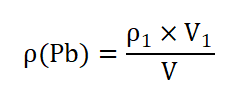- Princípio do método
After appropriate pretreatment, the sample is injected into a graphite tube atomizer. Lead ions are dissociated into atomic vapor at high temperatures within the graphite tube. The ground-state atoms of the target element absorb the resonance line emitted by a lead hollow cathode lamp, and the absorption intensity is proportional to the lead concentration within a certain range, enabling quantitative analysis of lead content.
- Instrumentos e reagentes
- Instruments and Equipment
– Detection Instruments:
– Temperature-controlled electric hot plate (room temperature–300°C)
– 10 mL colorimetric tubes
– Micropipettes (20μL–200μL, 100μL–1000μL, 1000μL–5000μL)
– 100 mL and 1000 mL volumetric flasks
– Pretreatment Equipment: Same as detection instruments, used for sample digestion and solution preparation.
- Reagentes
– Key Reagents:
– MOS-grade nitric acid.
– 1+99 nitric acid solution: Add 10 mL of nitric acid to a 1000 mL volumetric flask containing a small amount of water, then dilute to the mark with water.
- Soluções padrão:
– Stock Solution: GBW(E)082818-2 lead standard stock solution, 1000 μg/mL.
– Intermediate Solution: 100 μg/mL (prepared by diluting 10.0 mL of stock solution to 100 mL with 1+99 nitric acid; stable for 1 week).
– Working Solution: 1.0 μg/mL (prepared by diluting 1.0 mL of intermediate solution to 100 mL with 1+99 nitric acid; freshly prepared before use).
– Standard Series: 0.00, 2.50, 5.00, 10.00, 20.00, 30.00, 40.00 μg/L (prepared by diluting the working solution).
Iii.
- Preparação de amostras
– Pretreatment:
– Clear water samples can be directly measured.
– Samples with high suspended solids require acidification and digestion of organic matter (specific digestion steps not detailed).
– Standard Solution Preparation: Stepwise dilute the stock solution to prepare intermediate, working, and standard series solutions, all made up to volume with 1+99 nitric acid.
- Teste de amostra
– Testing Conditions:
– Spectral Parameters:
– Wavelength: 283.3 nm
– Spectral bandwidth: 0.4 nm
– Element lamp current: 3.0 mA
– Background correction: Deuterium lamp
– Injection volume: 15 μL
– Graphite Furnace Heating Program:
– Drying: 110°C, 10 s ramp-up, 10 s hold, high internal gas flow.
– Ashing: 350°C, 10 s ramp-up, 10 s hold, high internal gas flow.
– Atomization: 1700°C, 0 s ramp-up, 3 s hold, internal gas flow off.
– Cleaning: 1900°C, 1 s ramp-up, 2 s hold, high internal gas flow.
– Measurement Steps: Inject reagent blank, standard series, and samples into the graphite tube to measure absorbance. Subtract the blank absorbance from each standard solution’s absorbance, plot a working curve with absorbance (ordinate) against lead concentration (abscissa), and determine the lead concentration of the sample from the curve.
- Cálculo de resultados

Onde:
-ρ(Pb): Lead concentration in the water sample (μg/L);
-ρ1: Lead concentration of the sample obtained from the calibration curve (μg/L);
-V1 : Volume of the tested sample (mL);
– V: Volume of the original water sample (mL).
- Parâmetros metodológicos
- Minimum Detectable Mass Concentration
– Detection Limit: Calculated from 11 blank measurements. Standard deviation S0 = 0.00044, calibration curve equation A = 0.0060C + 0.0013, correlation coefficient 0.99915. Detection limit: 0.22μg/L; minimum detectable mass concentration: 0.88μg/L.
- Precisão
– Verification Results: Seven repeated measurements of the same sample yielded an average absorbance of 0.1509, standard deviation of 0.0046, and relative standard deviation (RSD) of 3.0%, meeting precision requirements.
- Accuracy
– Standard Sample Testing:
– Sample 201237 (standard value: 42.0 ng/mL): Average measured value 42.425 ng/mL, within the expanded uncertainty (3.1 ng/mL).
– Sample 201236 (standard value: 152.0 ng/mL): Average measured value 147.85 ng/mL, within the expanded uncertainty (12 ng/mL).
- Actual Sample Measurement
– Parallel measurements of three surface water samples showed relative errors of 3.62%–4.31%, meeting parallelism requirements.
- Precauções
– Pretreat water samples with high suspended solids to eliminate organic interference.
– Prepare standard solutions via stepwise dilution to ensure concentration accuracy.
– Strictly control the graphite furnace heating program to avoid background interference and incomplete atomization.







